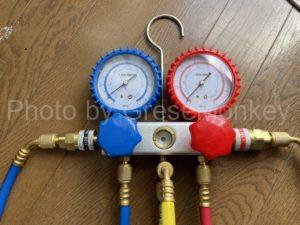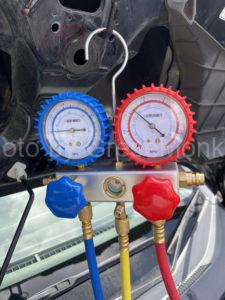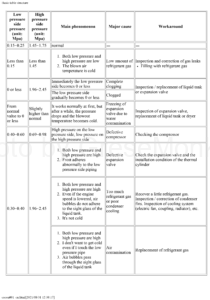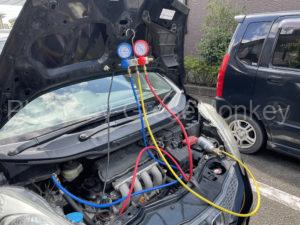How to use the manifold gauge
table of contents
- Checking car air conditioner refrigerant pressure
- How to fill car air conditioner refrigerant gas
- Car air conditioner vacuuming method
Checking car air conditioner refrigerant pressure
- Park the car in a safe place and stop the engine.
- Fully close the low-pressure valve and high-pressure valve of the gauge, and hang the gauge body on the hood of the car.
- Connect the low pressure coupler to the low pressure port of the car and the high pressure coupler to the high pressure port.
- At this time, pay attention to the handling so that the gauge hoses do not get caught in the engine belt or pulley.
- Check the gauge value at this time.
- At this time, do not open the low-pressure and high-pressure valves of the gauge.
- If the gauge remains 0 and does not move, there is no refrigerant gas.
- Start the engine with both the low-pressure and high-pressure valves fully closed, and perform the following operations.
- Fully open the car door.
- Set the engine speed to about 1500 rpm.
- Turn on the air conditioner switch.
- Make the air conditioner temperature the strongest.
- Set the blower fan to Hi.
- Switch to internal air circulation.
- Read the gauge in the above condition.
- Please refer to the service manual etc. as the appropriate value differs depending on the vehicle model.
- If the outside temperature is low (outside temperature 15 ° C or less), the pressure may not rise and correct measurement may not be possible.
- Gauge removal procedure
- Check if the low pressure and high pressure valves are fully closed.
- Stop the air conditioner and engine.
- Wait until both the low pressure and high pressure gauges reach the same pressure.
- After confirming that the pressure values are the same, remove the coupler in the order of the low pressure port and high pressure port of the car.
- Low pressure / high pressure gauge Pressure aptitude table (reference): When the outside temperature is about 30 ° C
How to fill car air conditioner refrigerant gas
Connect the service can valve to the HFC-134a (R134a) refrigerant gas can
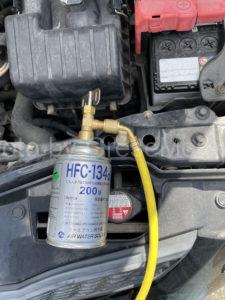
When the wing-shaped open / close valve on the upper side of the service can valve is tightened clockwise, a hole is opened in the refrigerant can and the refrigerant flows to the yellow charge hose.
- Fully open the open / close valve of the service can valve
- Turn counterclockwise to the end.
- When the open / close valve is fully opened, it means that the needle that makes a hole in the can is retracted.
- Install the service can valve while tightening it into the HFC-134a (R134a) refrigerant gas can.
- Tighten firmly so that the refrigerant gas does not leak.
- Do not turn the open / close valve until the charge hose is connected to the service can port.
As a general rule, fill the refrigerant gas according to the service manual, etc.
- Stop the car engine.
- Use the hook to hang the gauge body on the hood.
- At this time, the low pressure valve and the high pressure valve are fully closed.
- Connect the charge hose to the port of the service can valve.
- At this time, the opening / closing valve of the service can valve is fully closed.
- Note that if the on-off valve is fully opened, the refrigerant gas can will be punctured, gas will leak, and the service can valve cannot be removed until the refrigerant gas can is empty.
- Connect low-voltage and high-voltage couplers to each of the low-voltage and high-voltage ports of the car.
- Pay attention to the blowout of refrigerant gas.
- Be careful when handling the hoses so that they do not get caught in the engine belt or pulley.
- Remove the air purge cap and bleed the air inside the charge hose.
- Start the engine with both the low-pressure and high-pressure valves fully closed, and perform the following operations.
- Fully open the car door.
- Set the engine speed to about 1500 rpm.
- Turn on the air conditioner switch.
- Make the air conditioner temperature the strongest.
- Set the blower fan to Hi.
- Switch to internal air circulation.
- Read the gauge in the above condition.
- Please refer to the service manual etc. as the appropriate value differs depending on the vehicle model.
- If the outside temperature is low (outside temperature 15 ° C or less), the pressure may not rise and correct measurement may not be possible.
- Open the open / close valve of the service can valve and slowly open the low pressure valve halfway.
- Check the sight glass on the gauge body to make sure it is not filled in a liquid state.
- Never open the high pressure valve. Refrigerant gas may flow back into the service can and explode.
- When the high pressure gauge reaches the specified pressure value, close the low pressure valve and check whether the low pressure gauge and the high pressure gauge are the specified values.
- If the specified value is not reached, the low pressure valve is half-opened again and the filling of the refrigerant gas is continued until the specified value is reached.
- Be careful of overfilling when filling the refrigerant gas.
- Follow the procedure below to remove the manifold gauge.
- Fully close the open / close valves of the low pressure valve, high pressure valve, and service can valve.
- Turn off the air conditioner switch and stop the engine.
- Wait for the low pressure gauge and the high pressure gauge to reach the same pressure.
- After confirming that the pressure is the same, remove the coupler in the order of the low pressure port and high pressure port of the car.
- About air bleeding of 5 charge hose
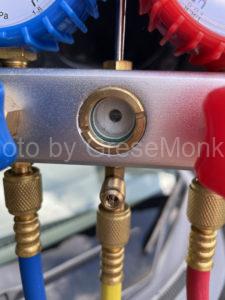
The air purge valve protrudes from the attachment part to the charge hose at the bottom center of the screen.
-
- Open the low pressure valve and push the air purge valve with a small screwdriver.
- After air purging, fully close the low pressure valve.
- Loosen the service can valve slightly and push the air purge valve with a small screwdriver.
- After air purging. Tighten and close the service can valve.
- Install the air purge cap.
Car air conditioner vacuuming method
- Stop the car engine.
- Park in a safe place.
- Use the hook to hang the gauge body on the hood.
- At this time, the low pressure valve and the high pressure valve are fully closed.
- Connect the charge hose to the port on the vacuum pump side.
- At this time, turn off the power of the vacuum pump.
- Connect low-voltage and high-voltage couplers to the low-voltage and high-voltage ports of the car, respectively.
- Pay attention to the blowout of refrigerant gas.
- Be careful when handling hoses.
- Turn on the power of the vacuum pump.
- To operate the vacuum pump, follow the tutorial that came with the vacuum pump.
- Open the low-pressure valve and then the high-pressure valve in that order, and leave them for about 5 minutes.
- If the gauge does not move in the negative pressure direction, there is a possibility of poor contact with the charge hose, so check the connection status.
- For the time required for evacuation, refer to the service manual of each car.
- After leaving it for about 5 minutes, fully close the low-pressure valve and high-pressure valve.
- Make sure that the gauge does not move while indicating the negative pressure direction.
- At this time, the inside of the air conditioner piping is in a vacuum state.
- After confirming that the gauge does not move, open the valve again in the order of 1: low pressure valve, 2: high pressure valve.
- Do not make a mistake in the order of opening.
- If the gauge pointer does not move while showing a negative pressure value even when the valve is open, the inside of the air conditioner piping is in a vacuum state.
- When the evacuation is completed, close the low pressure valve and high pressure valve fully and stop the vacuum pump.
- In this state, leave it for 5 to 10 minutes and check that the gauge does not return to 0MPa.
- If the gauge returns to 0MPa, there is a leak in the air conditioner piping, so inspect and repair it, and then evacuate it again.
- Refrigerant gas is injected from the state where evacuation is completed.
- The engine and air conditioner should be stopped.
- Attach the air conditioner refrigerant can to the charge hose and push the air purge valve of the manifold gauge to bleed the air in the pipe.
- Fully open the low pressure valve and inject one can of air conditioner refrigerant gas. At this time, never start the engine.
- Inject while shaking the air conditioner refrigerant can, and when it is confirmed that the gauge pointer is the same for both low pressure and high pressure (about 0.6 MPa for the first can) and it does not move, close the low pressure valve fully.
- Attach the second can of the air conditioner refrigerant to the charge hose, push the air purge valve, and bleed the air in the charge hose again.
- 「As a general rule, fill the refrigerant gas according to the service manual, etc.」Charge the air conditioner gas in the order from 6 of this item.
